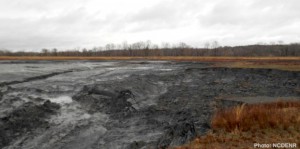Front Porch Blog
The day we’ve been waiting for has finally come. Yes it’s Friday, but today was also the U.S. Environmental Protection Agency’s court-imposed deadline to release federal regulations for coal ash storage and disposal.
As expected, the rule it took the EPA five years to finalize is modest at best, falling short of what it takes to truly address the prevalent problems associated with coal ash such as contamination of waterways and drinking water supplies.
Rather than classifying coal ash as the hazardous waste it clearly is, the EPA rule places it under Subtitle D of the Resource Conservation and Recovery Act, the nation’s primary law for regulating solid waste. Other types of waste regulated under Subtitle D include household garbage — you know, banana peels, candy wrappers and the like.
“For the thousands of citizens whose groundwater is no longer safe for consumption due to leaching ponds or whose air is contaminated by fugitive dust, failing to regulate coal ash as hazardous is a slap in the face,” says Amy Adams, Appalachian Voices’ North Carolina campaign coordinator. “While we’re pleased that we finally have federal regulations, they are far from perfect and demand we continue fighting for cleanup of these toxic sites.”
U.S. coal plants produce around 140 million tons of coal ash each year. Much of that is stored near waterways in unlined pits held in place by earthen dams. Even years after coal plants have closed, ponds that have stored toxic coal ash for decades can continue to pollute water and put communities at risk.
In 2012, Appalachian Voices and several partner groups, represented by Earthjustice, sued the EPA in federal court to force the agency to issue a rule. Late last year our coalition reached a settlement holding the EPA to today’s deadline.
According to the EPA, the rule establishes safeguards to protect communities from catastrophic spills, like the Kingston, Tenn., spill in 2008. It was the disaster in Kingston that spurred the agency to act.
But more spills, like the one at Duke Energy’s retired Dan River plant in Eden, N.C., have happened in the time since, representing hundreds of millions of dollars in environmental and economic costs.
To address the threat of another catastrophic failure, the EPA rule calls for the closure of inactive sites that fail to meet engineering and structural standards, more frequent inspections and monitoring, and restrictions on where coal ash impoundments are located.
The rule also requires water quality monitoring and public disclosure of the results, which should help groups like Appalachian Voices and our community partners better track pollution and take companies to court that fail to stop it. More frequent reports and accurate information coming directly from utilities could be a big boost for efforts to protect clean water, as long as coal plant operators commit to transparency.
But while the regulations set a minimum federal criteria, states are not required to adopt them, develop a permitting program, or submit a program to the EPA for approval. That’s all more of a suggestion, really. So while the EPA says it expects states to be “active partners” in regulating coal ash, well, states unfriendly to the EPA may feel differently. And should states refuse to clean up coal ash pollution or fail to meet the new standards, the EPA will not step in to enforce the rule. That job will still fall to citizens who identify the insidious pollution and file lawsuits to correct it.
According to Earthjustice, unsafe disposal of coal ash into the nation’s more than 1,400 coal ash dumps has contaminated more than 200 rivers, lakes, streams and sources of underground drinking water in 37 states. There are 331 high- and significant-hazard coal ash ponds in the country. Many of the highest hazard sites are concentrated in the eastern U.S.
Learn more about our work to clean up coal ash.
PREVIOUS
NEXT
Related News

Leave a comment
Your email address will not be published. Required fields are marked *


In three days, it will be six years since the Kingston coal ash spill occurred at Harriman. These regulations quintessentially exemplify EPA inaction under the Obama Administration (not that the Agency did much better under anyone else). To not regulate coal ash as being a hazardous waste is pure and utter bullshit. So we have more toothless jargon-laden inefficacy passed off as concerned government. Wouldn’t want to offend King Coal. Even more, wouldn’t want to speak out against Obama’s continually evidenced indifference to the ravages of mountaintop removal mining. Democrats are Republicans, Republicans are right-wing lunatics, and all payoff goes to the corporations, while the people and land of Appalachia are sacrificed without end.